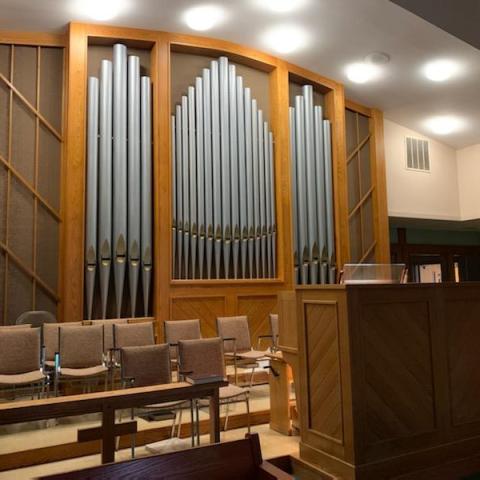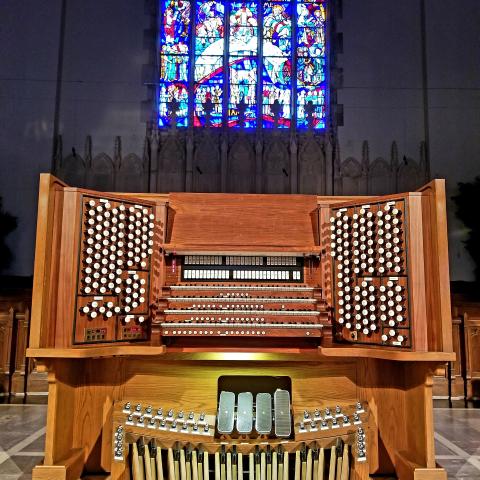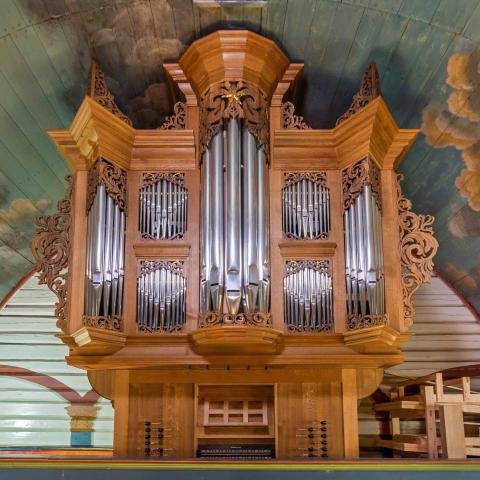
Russell Meyer & Associates, Lawrenceville, Georgia, Opus 14
First Presbyterian Church, Clarkesville, Georgia
Historic First Presbyterian Church of Clarkesville, Georgia, was built in 1848 by Jarvis Van Buren, a first cousin of President Martin Van Buren. The first pipe organ in the building was installed in the rear gallery by the Greenwood Pipe Organ Company in 1983.
The Atlanta Pipe Organ Sales & Service Company rebuilt and enlarged the Greenwood organ to seven ranks in 1989, retaining a set of twelve old 16′ Bourdon pipes, a 4′ Principal, a tenor-C Dulciana, a set of swell shades, a set of Maas-Rowe chimes, and a rebuilt two-manual drawknob console originally made by the Skinner Organ Company in 1926 for First Methodist Church of Hendersonville, North Carolina. The 1989 organ included a new organ case, five ranks of new pipes manufactured by the Wicks Organ Company, and entirely new electro-mechanical windchests with schwimmers. The Great division consisted of two unenclosed ranks—an 8′ Principal and a 4′/2′ unit Octave—plus numerous borrowed stops from the Swell division. The Swell comprised an 85-note unit Rohr Flute, a 4′ Principal, a 37-note, tenor-C Tierce, and a pair of 49-note, tenor-C dulcianas without common bass. Because the organ had only one flute rank of 8′ pitch with a 16′ extension, the soft 16′ pedal stop (activated by means of dual valves) differed from the loud 16′ stop only in its lowest octave. The organ possessed no reed tone.
Russell Meyer & Associates were contracted to rebuild and enlarge the organ in 2020. We added six ranks of pipes from M. P. Möller Opus 9739 (1962), originally installed in Saint Mary-in-the-Highlands Episcopal Church, Cold Spring, New York. To make the Great division more independent from the Swell, we added a III–IV rank mixture with its quints derived from a 49-note 1-1⁄3′ rank and its unisons from a 49-note 1′ rank. We also added a delightful 73-note wooden Gedeckt and moved the former 49-note Dulciana Celeste from the Swell along with twelve Haskell bass pipes added from our inventory. We also included a borrowed 16′ voice in the Great that produces a balanced level of gentle 16′ manual tone not achievable by the clumsier means of a suboctave coupler.
In the Swell division we replaced the previous dulcianas with a pair of moderately scaled violes. Because the unison Viole is full-compass, we were able to employ it as a common bass for a warmly singing 8′ extension of the existing 4′ Principal, a very useful stop indeed. Perhaps most significant in terms of tonal variety was our addition of an 85-note unit 16′ Trumpet conveniently playable in every division. This Trumpet performs beautifully as both a chorus reed and a solo stop.
Improvements to the Pedal division include a 32′ resultant and a gentle 16′ stop that retains a different character and softer volume from its louder sister throughout the entire compass of the pedalboard. The provision of cantus stops also adds to the versatility of the instrument. It is quite surprising how effectively the revised Pedal division undergirds the full ensemble, yet is able to do almost anything the organist asks of it, be it a quiet bass, a sweet melody, or a bold pedal solo.
To accommodate the added ranks, we expanded the organ case in matching appearance to double its previous size. We retained the existing console shell, bench, keyboards, and pedalboard but supplied all new thumb pistons, toe studs, drawknobs, tilting tablets, and a digital console clock. We manufactured new key slips, stop jambs, coupler rail, and music rack, and provided LED console lighting. We reconfigured the winding system and built new electro-mechanical windchests for five ranks, two additional schwimmers, and a seven-bell Zimbelstern of our own design. A new Opus-Two control system provides a 250-level combination action, piston sequencer, transposer, and built-in record/playback that operates totally on internal memory. We also installed a new 64-stage electric swell motor, as well as LED work lights inside the organ case.
I acknowledge and thank my colleagues and friends who worked with me on the construction, installation, and tonal finishing of this organ: Allen Colson, Joshua Crook, Tommy McCook, Michael Proscia, Corley Easterling, Bud Taylor, and Tom Wigley. John Thomas and Stephen McCarthy assisted with the removal of the Cold Spring instrument.
We are grateful to the church Session, the congregation, and the staff for entrusting us with this project. Reverend Matthew Henderson is the pastor, Areatha Ketch is music director, and Sandra Altman is organist.
—Russell Meyer, president
Builder’s website: rmeyerpipeorgans.com
Church website: fpccga.org
GREAT (Manual I, unenclosed)
16′ Dolce Bass (ext, common bass)
8′ Open Diapason 61 pipes
8′ Gedeckt (wood) * 61 pipes
8′ Dulciana (1–12 added *) 61 pipes
4′ Octave 61 pipes
4′ Gedeckt Flute (ext 8′) * 12 pipes
2′ Super Octave (ext 4′) 12 pipes
III–IV Mixture (1-1⁄3′, derived) * 98 pipes
8′ Trumpet (Sw)
4′ Clarion (Sw)
Chimes 21 tubes
Zimbelstern * 7 bells
Swell to Great 16
Swell to Great
Swell to Great 4
SWELL (Manual II, enclosed)
8′ Violin Diapason (ext, common bass)
8′ Rohr Bourdon 61 pipes
8′ Viole * 61 pipes
8′ Viole Celeste (TC) * 49 pipes
4′ Principal 61 pipes
4′ Rohr Flute (ext 8′) 12 pipes
2-2⁄3′ Nazard (ext 8′ Rohr Flute)
2′ Block Flute (ext 8′) 12 pipes
1-3⁄5′ Tierce (TC) 37 pipes
1-1⁄3′ Larigot (ext 8′ Rohr Flute)
16′ Double Trumpet (ext 8′) * 12 pipes
8′ Trumpet * 61 pipes
4′ Clarion (ext 8′) * 12 pipes
Tremulant
Swell to Swell 16
Swell to Swell 4
PEDAL (unenclosed)
32′ Harmonic Bass (1–12 resultant)
16′ Subbass (wood, ext Sw) 12 pipes
16′ Lieblich Gedeckt (ext Gt, soft wind)
8′ Open Diapason (1–12 fr Gt Open Diapason; 13–32 fr Gt Octave)
8′ Gedeckt Bass (Gt)
4′ Choral Bass (Gt 4′ Octave)
4′ Gedeckt Flute (Gt 8′)
16′ Double Trumpet (Sw)
8′ Trumpet (Sw)
4′ Clarion (Sw)
Great to Pedal
Swell to Pedal
Swell to Pedal 4
* added pipes
12 ranks, 756 pipes







